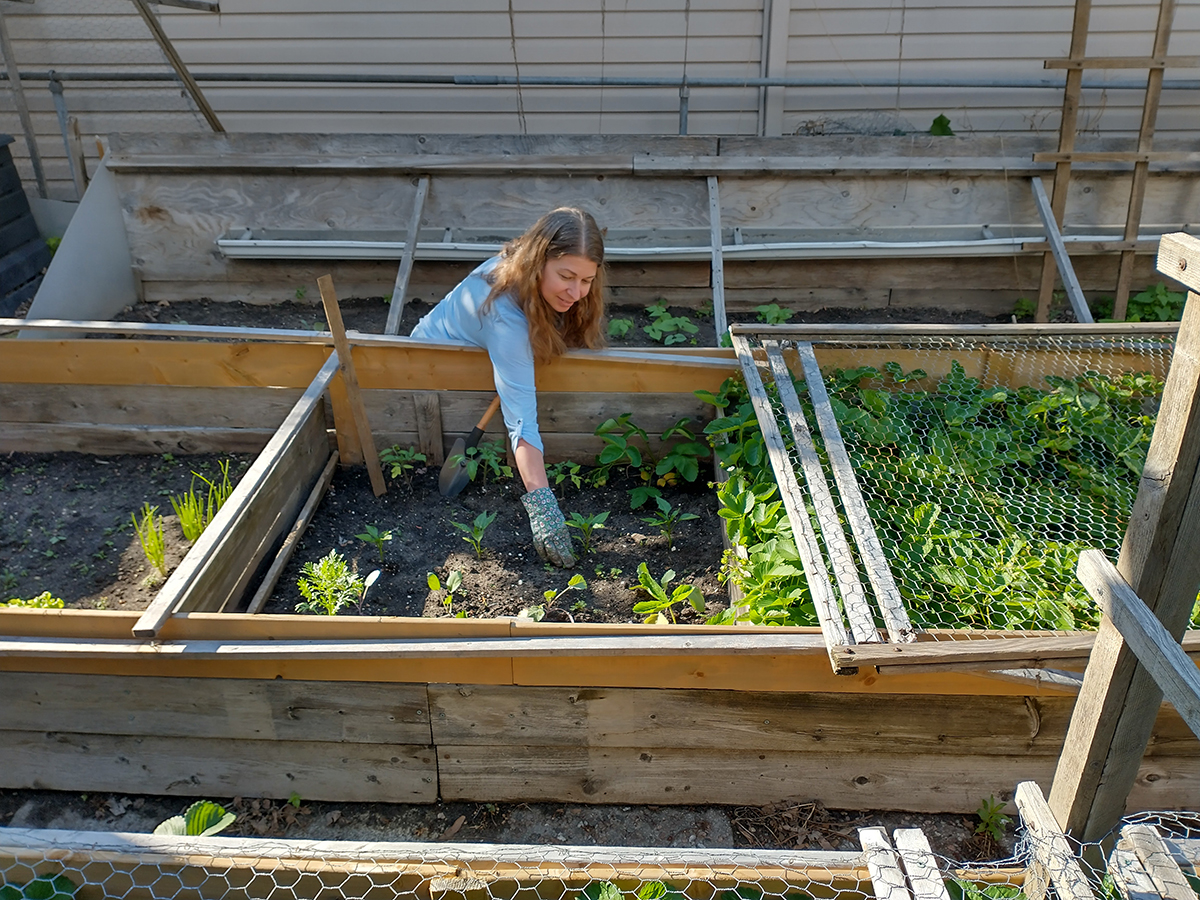Dr. Irena Knezevic is an assistant professor of communication studies at Carleton University in Ottawa, Canada. She has worked in the realm of ‘alternative food’ for over a decade, with her work largely focussed on community-embedded research. Dr. Knezevic’s presentation at the Food Matters & Materialities Conference was helpful for thinking about the unseen activities that support food systems, which include community food initiatives. As well, Dr. Knezevic helps us to understand how their contribution extends beyond economic measurement. Here’s how my interview with Dr. Knezevic went.

Credits: Courtesy of Irena Knezevic.
JW: Can you explain what the realm of alternative food is?
IK: Alternative food is only one of the terms that can be used to describe many of the initiatives that have sprouted all around the globe in the last couple of decades. It refers to alternatives to the industrial food system. The industrial food system is this sort of large corporate approach to producing a lot of food in terms of yields but also processing it in a way that makes it more shelf-stable and allows food to be transported across larger distances. The industrial food system is what we encounter in every grocery store that we go to.
Alternative models are models that challenge that industrial system in one way or another. Sometimes they challenge it because they’re more focused on local food, or sometimes they challenge it on an environmental basis, meaning they may look for more environmentally sustainable ways to produce food even if that kind of approach doesn’t yield as much in terms of quantity but allows for more sustainable farming. So alternative food is the umbrella term that I have used with my collaborators across several projects to distinguish resistance and modes of providing, growing, and procuring food that counters that industrial model.
JW: You mentioned that your work builds on ‘more than a decade of community-engaged research of the Nourishing Communities Network’. What led you to work with the Network?
IK: I started collaborating with the Nourishing Communities Network as a research assistant more than a decade ago when I was still a graduate student. The network is a sort of network of people and projects that we collaborate on. We initially started looking at local food initiatives in Ontario and then expanded nationally and then internationally. We then started to look more at community-based initiatives that look at ways to provide sustainable and more socially-just food. And through this, we focused on social justice and access to affordable, healthy food. We started to see a lot of similarities in terms of the values that some of these initiatives were carrying, so we borrowed this term, “alternative food”, from other researchers because it seemed to resonate. I really landed in that research through my collaborations, particularly with community groups, where we started to realize that they just didn’t get a lot of airtime in policymaking and other realms where we think their voices are important to be heard.
JW: As a professor in communication studies, what is your role in the Network? Can you explain why communication is so important to community food initiatives?
IK: It’s a really interesting question because honestly when I started working with this network, I wasn’t sure where my place was in that group. I consider myself an interdisciplinary researcher, but as somebody who works in communication studies, I wasn’t really sure where my contribution could be. Over time though, the more we worked with community organizations, the more requests we got to help them think through how they communicate the value of what they’re doing. So many initiatives recognize that the communities they work in value their contributions; they recognize that some of the environmental contributions of agroecological farming, for instance, farming that pays attention to ecosystems and sustainability. They knew what they were doing was valuable, but because of the way things are typically evaluated, it was very hard for them to demonstrate the value with their doing. Typically, in the agri-food sector, we measure value through productivity and the contribution to the GDP [gross domestic product] as a standard way of assessing the state of agriculture. But really, looking at some of those contributions, they are sometimes difficult to measure. This was the challenge that many of the community partners identified to us and asked us to help them think through.
JW: In your presentation, you helped the audience recognize the importance of community initiatives and their activities that go unnoticed. Can you explain why emphasizing the value of these initiatives beyond economic measurements is important for their success and growth?

Credits: Courtesy of Irena Knezevic.
IK: In my presentation, I talked about a framework that uses a metaphor of an iceberg to represent what we think about the economy. All we see is a small portion of the iceberg above the water’s surface. This portion includes things like GDP and other economic measures. But this is just a small portion of all the economic activities that take place in our lives. Those other economic activities include things like informal economies, unpaid labour, volunteer work, all kinds of other things.
When it comes to community food initiatives and their value beyond these measures, I gave an example in my presentation of one, which is an ‘alternative land use services program’. It started in Ontario and has been slowly expanding across Canada. It’s a program that gets private donors to incentivize farmers who are willing to take a part of their farm out of industrial production and regenerate that part of the land. This then reintroduces native plant species and a variety of other things that help restore ecosystems. If you think about being a farmer and say you have 100 acres of your farming, and somebody says that an environmentally responsible thing to do would be to take 10% of your land out of production. Well, that’s a great idea; you’re going to have a healthier ecosystem, you’re going to invite more pollinators and nesting birds, but it also means you might lose 10% of your income. This incentive program is one of the few programs that we have in Canada that recognizes, financially, the value of that work.
The values that we have in that example are the values of restoring ecosystems, which is something that we know and is becoming abundantly clear agriculture has been a problem for. We know that industrial, agricultural practices have contributed to climate change, a loss of diversity, naturalized spaces, and land. The value, then, of restoring the ecosystem is significant if we want to take on climate change head-on, but how do we measure the value of that? How do we attach a dollar value? We know the dollar values can’t meaningfully represent those contributions. How do we recognize that what they’re doing is worth investing in? I think one of the biggest challenges community initiatives face is attracting investments because this again requires working with dollar figures.
JW: You mentioned the impact that the COVID-19 pandemic has had on food systems and community food initiatives. As we continue to deal with the pandemic and as we come out on the other side, where do you think this research will go next?
IK: I really am hopeful that some of the work we have done will have some influence on policy thinking in Canada in particular. We have developed recommendations for a variety of different approaches that we have documented and observed with the community initiatives. These could work as potential solutions under this key phrase that was introduced by the federal government in Canada to ‘build back better’. During the Covid-19 pandemic, we’ve seen how the food system has been affected in really tragic ways. The industrial food system, including meat-processing plants in Canada, has seen some of the most significant and most serious outbreaks. This system also depends on temporary migrant farm workers who have also seen cases with fatal consequences of Covid-19. We know that even accessing grocery stores has been changed through all of this. So, this food system has now been exposed as being really broken and lacking in social justice considerations. If we’re going to think about how we rebuild that system after the pandemic, I think these are some of the key considerations that we take away from community food initiatives, and alternative food should be kept in mind. They’re not just feel-good suggestions. These are suggestions that can improve how we think through climate change and agri-food’s role in this. They can also push thinking towards more socially just parameters around how we grow, process, and distribute food in our society.
JW: Thank you so much for your insight and time, Dr. Knezevic!
This interview has been edited for length and clarity.